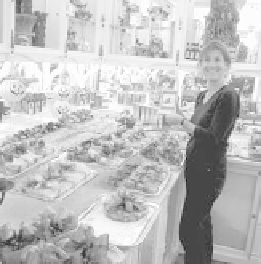Travel Reference
In-Depth Information
History of chocolate
In 1519, Montezuma served Cortés a cup of hot cocoa
(xocoatl)
made from cocoa beans, which were native to the New World.
It ignited a food fad in Europe—by
1700, elegant “chocolate houses” in
Europe's capitals served hot choco-
late (with milk and sugar added) to
wealthy aristocrats. By the 1850s,
the process of making chocolate
candies for eating was developed,
and Brussels, with a long tradition
of quality handmade luxuries, was
at the forefront.
Cocoa beans are husked, fer-
mented, and roasted, then ground
into chocolate paste. (Chocolate
straight from the bean is very bit-
ter.) The vegetable fat is pressed out to make cocoa butter.
Cocoa butter and chocolate paste are mixed together and
sweetened with sugar to make chocolates. In 1876, a Swiss
man named Henry Nestlé added concentrated milk, creat-
ing milk chocolate—a lighter, sweeter variation, with less pure
chocolate.
Galler,
just off the square at Rue au Beurre 44, is homier and
less famous because it doesn't export. Still family-run (and the
royal favorite), it proudly serves less sugary chocolate—dark. The
new top-end choice, 85 percent pure chocolate, is called simply
“Black 85”—and worth a sample if you like chocolate without the
sweetness. Galler's products are well-described in English.
At
Leonidas,
four doors down at Rue au Beurre 34, most
locals sacrifice 10 percent in quality to double their take by get-
ting their fix here (machine-made, only €1.60/100 grams). White
chocolate is the specialty.
•
Exit the Grand Place next to Godiva (from the northeast, or uphill,
corner of the square), and go north one block on Rue de la Colline (pass-
ing a popular Tintin shop at #13 and a Europe shop across the street)
to Rue du Marché-aux-Herbes, which was once the main east-west
highway through Belgium. Looking to the right, notice that it's all uphill
from here to the Upper Town, another four blocks (and 200-foot eleva-
tion gain) beyond. Straight ahead, you enter the arcaded shopping mall
called...
Galeries Royales St. Hubert
Europe's oldest still-operating shopping mall, built in 1847, served
as the glass-covered model that inspired many other malls. It




















